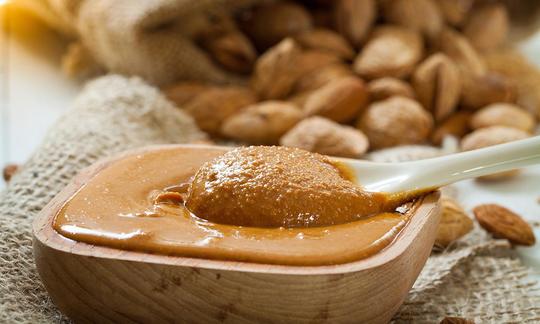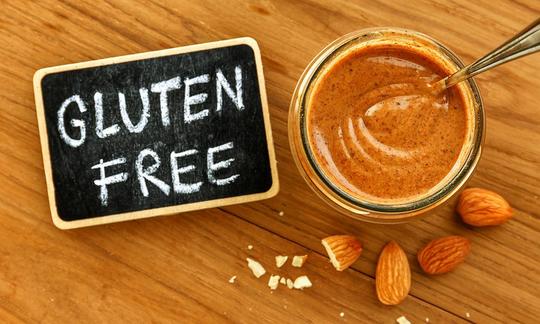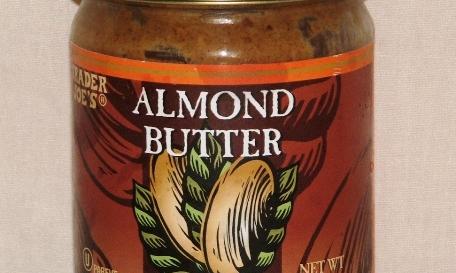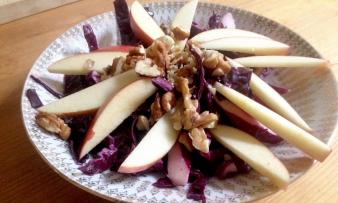Table of contents
Unsalted almond butter (almond puree) usually consists of 100% unpeeled almonds (dark). The puree is rich in vitamin E, unsaturated fatty acids, calcium, potassium and manganese and is made with roasted or unprocessed almonds ( raw), depending on the processing method. Make sure it is organic quality.
Use in the kitchen
What is almond butter? Almond butter is made from ground almonds ( Prunus dulcis var. dulcis). It is available in a light and dark variety. Light almond butter consists of peeled almonds. For the darker variety, unpeeled and partially roasted almonds are used. The darker almond butter has a more aromatic and nutty taste, while the lighter tastes slightly sweet. Both varieties can be used in cold and warm, sweet and savory dishes.
Is almond butter raw? If you roast the almonds at temperatures above 42 °C before processing, the almond butter is no longer considered raw. Almond butter is very popular as a spread for breakfast or as a snack. It gives sauces, curries and smoothies a creamy consistency. Its nutty flavour is excellent as an ingredient in a vegan red cabbage and apple salad with walnuts and almond butter or in pasta dishes with mushrooms and vegetables. It is used in baking, e.g. in a vegan exotic banana bread with mango and ginger, or in the form of homemade ice cream or as a dessert. The almond flavour also goes well with (dried) fruit and other nuts, e.g. cashews, macadamia nuts, hazelnuts or pecans. Apple pieces can be spiced up as a healthy raw food snack by dipping them in almond butter.
Homemade dark almond butter
Almond butter without sugar and without salt can be made in no time at all. For one jar (approx. 200 g content) you need 200 g of almonds (organic) and a high-performance blender. To make the homemade almond butter a success, you should soak the almonds in lukewarm water for at least four hours. Then put the almonds in the high-performance blender and grind until the consistency is firm and creamy. Depending on the blender, the production process takes 5 to 20 minutes. Finally, pour the mixture into a sealable container.
Vegan recipe for smoothie with almond butter (dark)
Ingredients (for 1 glass, approx. 300 ml): 1 banana, 1 handful of spinach, 1 handful of strawberries (fresh/frozen), 100 ml almond milk, 1 teaspoon of almond butter (dark).
Preparation: Put all ingredients, organic if possible, into a blender and puree well. Pour into a glass and enjoy the vegan smoothie.
For a sweeter version, add some agave syrup. 1 tablespoon of oatmeal or chia seeds will help make the smoothie a little creamier.
Vegan recipe for porridge with dark almond butter
Ingredients (for 2 servings): 1 banana, 1 tbsp almond butter (dark), 380 ml oat milk, 100 g oat flakes, 1 tbsp flaxseed, 1 pinch of salt, ½ vanilla pod, 1 tbsp maple syrup (optional).
Preparation: Cut the banana into slices, remove the pulp from the vanilla pod and put it in a pot with all the ingredients except the almond paste and bring to the boil. Reduce the heat and simmer until a creamy porridge is formed. Pour the vegan porridge into a bowl and serve with the almond paste.
Vegan recipes with almond butter (dark) can be found under the note: " Recipes that have the most of this ingredient ".
| Not only vegans or vegetarians should read this: Vegans often eat unhealthily. Avoidable nutritional errors. |
Purchasing - Storage
Supermarkets such as Coop, Migros, Spar, Aldi, Lidl, Rewe, Edeka, Hofer, Billa stock almond butter (unsalted) either in their standard range or at least as part of a special offer. Denner and Volg rarely have almond butter on offer. Organic supermarkets such as Denn's Biomarkt and Alnatura offer both dark and light almond butter in organic quality. In online stores, almond butter can be found under the name "almond butter". In contrast to nut butter, vegetable oil is often added to nut butter to make it easier to spread. Since there are no general guidelines for the designation of nut butter or nut butter, it is sometimes necessary to look at the ingredients in ready-made products. We use the term "almond butter" here as a synonym for "almond butter".
The availability of almond butter varies depending on the size of the store, catchment area, etc. Our recorded food prices for the DA-CH countries can be found above under the ingredient image - and by clicking you can see their development at various suppliers.
Storage tips
Unsalted almond butter usually has a long shelf life if stored in a cool, dry place. If an oily film forms during long-term storage, there is no need to worry. It protects the puree from spoiling and is quickly mixed with the rest of the puree.
Ingredients - Nutritional values - Calories
Is almond butter vegan? Yes, almond butter is naturally vegan and gluten-free. Dark almond butter has 614 kcal per 100 g, is very high in fat (56 g) and rich in protein (21 g). The carbohydrate content is 19 g/100g, of which 10 g arefiber. Although the fat it contains consists mainly of unsaturated fatty acids, dark almond butter has an unfavorable ratio of inflammation-promoting omega-6 fatty acids (linoleic acid; LA) to anti-inflammatory omega-3 fatty acids (alpha-linoleic acid; ALA) (see chapter Dangers - Intolerances - Side effects). 1
With 24 mg per 100 g (202% of the daily requirement), almond butter is rich in vitamin E. This is mainly found in nuts, vegetables and fruit. In addition to raw almonds (26 mg/100g), hazelnuts (15 g/100g) also contain higher amounts of this vitamin. Peanut butter contains significantly less (6.3 mg/100g). 1
Manganese is present in almond butter at 2.1 mg/100g (107% of the daily requirement). Peanut butter has similarly high levels (1.8 mg/100g). This important trace element is found primarily in nuts and seeds. Hazelnuts contain almost three times as much manganese at 6.2 g/100g and walnuts (tree nuts) are also good sources of manganese at 3.4 mg/100g. 1
Dark almond butter contains higher amounts of magnesium (279 mg/100g; 74% of the daily requirement). This essential mineral is involved in more than 300 enzymatic metabolic reactions and is also found in nuts and seeds. Similar amounts are found in cashew butter (258 mg/100g). Peanut butter contains 160 mg/100g and tahini (sesame butter) 95 mg/100g. 1
Almond butter has nutritional advantages over peanut butter. Almond butter contains significantly more fiber, calcium, potassium, iron and manganese. In addition, the puree only has about half the saturated fatty acids - despite a slightly higher total fat content. Almond butter also has more than three times the amount of vitamin E compared to peanut butter . 1
The complete ingredients of dark almond butter (unsalted), the coverage of the daily requirement and comparison values with other ingredients can be found in our nutrient tables. In the article Nutrients explained you will get a detailed insight into the topic.
Health effects
Almonds ( Prunus dulcis var. dulcis) have a positive effect on reducing the risk of cardiovascular disease due to their antioxidant properties, among other things, by lowering blood pressure and cholesterol in the blood. They are also a possible source of folic acid when there is an increased need (e.g. during pregnancy). You can find out more about the health effects of almonds and their omega-3 to omega-6 ratio in the article Almonds (sweet almonds), raw.
The popularity of nut and seed butters has increased significantly in recent years. The development of technology and the growing awareness and interest in plant-based diets have led to the development of countless types of butter based on various nuts and seeds. These alternatives are establishing themselves as good sources of protein, fiber, essential fatty acids and other nutrients. The butter form is a healthy way to incorporate nuts and seeds into the diet. 2 Despite the growing range of alternatives to animal butter, only a few studies have examined the health effects of almond butter. The effects may also vary depending on the production process and composition.
A study from the USA with 38 participants with hypercholesterolemia (too much cholesterol in the blood) showed that the daily consumption of 100 g of almond butter (roasted), in combination with a plant-based diet, significantly reduced LDL (low-density lipoprotein) and slightly increased HDL (high-density lipoprotein) in the blood. Blood pressure did not change significantly. 3 The job of LDL is to transport cholesterol from the liver to the body's cells. If the cells no longer absorb the LDL cholesterol, it remains in the blood, changes its structure and leads to deposits on the artery walls. HDL is responsible, among other things, for the return transport of cholesterol to the liver (for excretion there). HDL therefore contributes significantly to healthy arteries and reduces the risk of coronary heart disease. Is almond butter healthy? Almond butter undoubtedly contains important nutrients and, when consumed in moderation, is a good source of ( monounsaturated and polyunsaturated) fatty acids. Further research is needed to confirm its health benefits.
Dangers - Intolerances - Side effects
People who are allergic to nuts should also be careful when consuming almonds ( Prunus dulcis var. dulcis) and products made from them.
Almonds are often roasted before being processed into almond butter to give them a more intense flavor. This Maillard reaction produces, among other things, the substance acrylamide, which is classified as carcinogenic. This begins to form at 130 °C during the roasting process of almonds and increases more rapidly at 146 °C. Compared to hazelnuts, almonds contain a much higher content of free asparagine, which is why more acrylamide is formed during roasting. In addition to the concentration of free asparagine, the roasting temperature is the most important factor influencing the formation of acrylamide in almonds. By selecting almonds with a low content of free asparagine and by lowering the roasting temperature, the acrylamide content can be reduced. 19,20,21
Due to its high fat content and high calorie count, almond butter should be consumed in moderation. The fats it contains also contain high amounts of omega-6 fatty acids (linoleic acid; LA) and hardly any omega-3 fatty acids (alpha-linoleic acid; ALA). The human body must obtain both fatty acids from food. The Western diet is generally rich in omega-6 and poor in omega-3 fatty acids. 4 Excessive amounts of polyunsaturated omega-6 fatty acids and a very high omega-6/omega-3 ratio promote the development of numerous diseases, including cardiovascular diseases, cancer, and inflammatory and autoimmune diseases. 5 A maximum ratio of 5:1 (LA:ALA) is still considered desirable. Instead of a ratio, the Federal Nutrition Commission ( EEK) now advocates absolute intake levels and recommends amounts of polyunsaturated fatty acids of 2.5-9% (omega-6 fatty acids) or 0.5-2% (omega-3 fatty acids) of the daily energy requirement. This corresponds to a maximum of 20 g per 2000 kcal (omega-6 fatty acids) or 1-4.4 g per 2000 kcal (omega-3 fatty acids). 6
The intake of omega-6 fatty acids is significantly higher in vegans and vegetarians than in omnivores. As a rule, the ratio of omega-6 to omega-3 fatty acids is higher in vegans (< 14:1-20:1) and lacto-vegetarians (< 10:1-16:1) than in omnivores (< 10:1). 7 A high consumption of cashew nuts, peanuts, hazelnuts, almonds, sunflower seeds, and products made from them such as butter and vegetable oils can lead to this ratio and promote inflammatory processes in the long term.
We can only warn: vegans and vegetarians who are misinformed or uninformed generally live worse than normal eaters - and a study is sure to come out that will ruthlessly expose this (see our article Vegans often eat unhealthily - avoidable nutritional errors). This could stop the vegan hype that is so important for animal welfare and the environment and discredit the oriented minority. This has been our fear since 2014! See this link to see what happened with raw food: The Giessen raw food study.
Ecological footprint - animal welfare
The CO 2 footprint of a food depends on various factors. The type of agricultural production (conventional vs. organic), seasonal, regional, domestic production or import by truck, ship or plane, different types of packaging and whether the goods are fresh or frozen all play a decisive role. 10
According to Carboncloud, almond paste from Italy has 4.87 kg CO 2 eq/kg. 12 That is a large footprint; similar to that of average pork, milk chocolate or cream. 10 Another calculation came to 2.89 kg CO 2 eq/kg for American almond paste and 3.07 for European almond paste. 13
The good thing about almonds is that their production causes few greenhouse gases in relation to their nutritional value. All you can eat for climate, a cooperation project between various research and environmental organizations, awarded almonds the rating "In the goal of climate-friendly nutrition: 50% better than the average." In this study, almonds had 2.12 kg CO 2 eq/kg; this is a good climate balance, especially in relation to their nutritional value: with 0.12 kg of almonds, you could theoretically cover 1⁄3 of your daily macronutrient requirement and thus consume 669 kcal. 16
A study from California shows similar values for peeled almonds at 1.92 kg CO 2 eq/kg, while the consumption of fresh water ('blue water') is 4820 l/kg. Regional differences lead to fluctuations in these data and can result in a CO 2 footprint of up to 2.69 kg CO 2 eq/kg; fresh water consumption also fluctuates between 4540 and 5150 liters. 11 If 'green water' (rainwater) and 'grey water' (dirty water) are included, the water consumption is much higher - see below.
Nuts generally have a high water consumption: the global average is 9063 l/kg. However, almonds exceed this value by several hundred liters. The authors Mekonnen and Hoekstra calculated the water footprint of peeled almonds and came up with an average of 16,095 l/kg. Of this, 9264 l is green water (rainwater), 3816 l is fresh water and 3015 l is grey water (fresh water required to treat pollutants). 14 It should be remembered that almonds are grown in water-scarce areas such as California or Italy. A single (!) Californian almond uses around 12 liters of water. The researchers who arrived at this figure put the water footprint into perspective by comparing it to its nutritional value and market value. Even though the Almond Board of California funded this study, it could still be relevant. 15
Well-thought-out, ecological cultivation methods are important in almond production. When buying almond butter, look for certifications from fair trade and organic production.
For detailed explanations of various sustainability indicators (such as ecological footprint, CO2 footprint, water footprint), see our article: What does the ecological footprint mean?.
Animal welfare - species protection
The common practice of growing almond trees in monocultures is bad for biodiversity, especially for bees. Paradoxically, beekeepers bring their swarms of bees to the almond monocultures to pollinate the enormous mass of flowers. Due to the use of various pesticides and additives, many of these bees die and become ill. 17 The cited source only mentions honey bees. But this bee is only one of 17,000 bee species worldwide. Bee populations are strongly negatively influenced by humans. We not only have an ethical responsibility to protect them, bees are also of enormous importance for our food security. Many other animal species, such as beetles, butterflies and birds, also depend on the survival of bees. 18
Worldwide occurrence - cultivation
Information on the origin, cultivation and harvest of almonds can be found directly on the ingredient. The increase in health-conscious consumers, especially in industrialized countries, has been a key driver of demand for almond butter in recent years. The growing popularity of plant-based diets and increasing awareness of healthy eating are contributing to further market growth. Europe had the largest market share in 2022. The countries with the highest consumption include the USA, Canada, the United Kingdom, France, Germany, China, India, Japan, Brazil and South Africa. 8
Industrial production
The industrial production of almond butter generally follows the same steps as in-house production, but differs depending on the manufacturer. After harvesting and quality control, the almonds go through a crushing and drying process to remove any residual moisture. They are then gently ground into a paste in stone mills. Some producers roast the almonds to give the almond butter a more intense flavor (Maillard reaction). 9 Some manufacturers use temperatures below 42 °C. With this production process, the dark almond butter can be described as a raw product.
Further information
The vitamins contained in almond butter are making the puree and its ingredients increasingly popular in the cosmetics industry. 8
Alternative names
Incorrect spellings, such as "mandelbitter" creep in. Almond puree is called "almond butter" in English.
Bibliography - 21 Sources (Link to the evidence)
| 1. | USDA United States Department of Agriculture. |
| 2. | Gorrepati K, Balasubramanian S, Chandra P. Plant based butters. J Food Sci Technol. 2015;52(7):3965–3976. |
| 3. | Spiller GA, Miller A et al. Effects of plant-based diets high in raw or roasted almonds, or roasted almond butter on serum lipoproteins in humans. Journal of the American College of Nutrition. 2003;22(3):195–200. |
| 4. | Simopoulos AP. Omega-6/Omega-3 Essential Fatty Acids: Biological Effects. In: Simopoulos AP, Bazan NG, Hrsg. Omega-3 Fatty Acids, the Brain and Retina. World Review of Nutrition Dietetics (Vol. 99). Basel: Karger; 2009:1-16. |
| 5. | Simopoulos AP. The importance of the ratio of omega-6/omega-3 essential fatty acids. Biomedicine & Pharmacotherapy. 2002;56(8):365–379. |
| 6. | Eidgenössische Ernährungskommission. EEK Bericht. Fette in der Ernährung. 2012 (pdf). |
| 7. | Davis BC, Kris-Etherton PM. Achieving optimal essential fatty acid status in vegetarians: current knowledge and practical implications. The American Journal of Clinical Nutrition. 2003;78(3):640-646. |
| 8. | Grand View Research com: Almond Butter Market Size, Share & Trends Analysis Report By Nature (Organic, Conventional), By Distribution Channel (B2B, B2C), By Region, And Segment Forecasts, 2023-2030. |
| 9. | BBC: How is almond butter ACTUALLY made? - BBC. 2019. |
| 10. | Reinhardt G, Gärtner S, Wagner T. Ökologische Fussabdrücke von Lebensmitteln und Gerichten in Deutschland. IFEU Institut für Energie - und Umweltforschung Heidelberg. 2020. |
| 11. | Marvinney E, Kendall A. A scalable and spatiotemporally resolved agricultural life cycle assessment of California almonds. Int J Life Cycle Assess. 2021;26(6):1123–1145. |
| 12. | Carboncloud. Schweden. Almond butter (Italy). 2023. |
| 13. | Volpe R, Messineo S et al. Carbon footprint of tree nuts based consumer products. Sustainability. 2015;7(11):14917–14934. |
| 14. | Mekonnen MM, Hoekstra AY. The green, blue and grey water footprint of crops and derived crop products. Hydrol Earth Syst Sci. 2011;15(5):1577–1600. |
| 15. | Fulton J, Norton M, Shilling F. Water-indexed benefits and impacts of California almonds. Ecological Indicators. 2019;96:711–717. |
| 16. | Greenpeace Schweiz, Stadt Zürich, Planted Foods AG, Branding Cuisine, Tinkerbelle, Inge, myblueplanet, ProVeg International, Dr. Earth, FightBack und Eaternity. All You Can Eatfor climate - Poster. ayce.earth. 2022. |
| 17. | Shannon B, Walker E, Johnson RM. Toxicity of spray adjuvants and tank mix combinations used in almond orchards to adult honey bees (apis mellifera). Journal of Economic Entomology. 2023;116(5):1467–1480. |
| 18. | Westrich P. Wildbienen: Die anderen Bienen. München: Verlag Dr. Friedrich Pfeil; 2015:7,74. |
| 19. | Zhang G, Huang G et al. Acrylamide formation in almonds (Prunus dulcis): influences of roasting time and temperature, precursors, varietal selection, and storage. J Agric Food Chem. 2011;59(15):8225–8232. |
| 20. | Lukac H, Amrein TM et al. Influence of roasting conditions on the acrylamide content and the color of roasted almonds. Journal of Food Science. 2007;72(1):C033-C038. |
| 21. | Amrein TM, Lukac H et al. Acrylamide in roasted almonds and hazelnuts. J Agric Food Chem. 2005;53(20):7819–7825. |














Comments